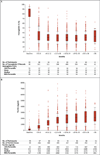Controlled trial of transfusions for silent cerebral infarcts in sickle cell anemia
- PMID: 25140956
- PMCID: PMC4195437
- DOI: 10.1056/NEJMoa1401731
Controlled trial of transfusions for silent cerebral infarcts in sickle cell anemia
Abstract
Background: Silent cerebral infarcts are the most common neurologic injury in children with sickle cell anemia and are associated with the recurrence of an infarct (stroke or silent cerebral infarct). We tested the hypothesis that the incidence of the recurrence of an infarct would be lower among children who underwent regular blood-transfusion therapy than among those who received standard care.
Methods: In this randomized, single-blind clinical trial, we randomly assigned children with sickle cell anemia to receive regular blood transfusions (transfusion group) or standard care (observation group). Participants were between 5 and 15 years of age, with no history of stroke and with one or more silent cerebral infarcts on magnetic resonance imaging and a neurologic examination showing no abnormalities corresponding to these lesions. The primary end point was the recurrence of an infarct, defined as a stroke or a new or enlarged silent cerebral infarct.
Results: A total of 196 children (mean age, 10 years) were randomly assigned to the observation or transfusion group and were followed for a median of 3 years. In the transfusion group, 6 of 99 children (6%) had an end-point event (1 had a stroke, and 5 had new or enlarged silent cerebral infarcts). In the observation group, 14 of 97 children (14%) had an end-point event (7 had strokes, and 7 had new or enlarged silent cerebral infarcts). The incidence of the primary end point in the transfusion and observation groups was 2.0 and 4.8 events, respectively, per 100 years at risk, corresponding to an incidence rate ratio of 0.41 (95% confidence interval, 0.12 to 0.99; P=0.04).
Conclusions: Regular blood-transfusion therapy significantly reduced the incidence of the recurrence of cerebral infarct in children with sickle cell anemia. (Funded by the National Institute of Neurological Disorders and Stroke and others; Silent Cerebral Infarct Multi-Center Clinical Trial ClinicalTrials.gov number, NCT00072761, and Current Controlled Trials number, ISRCTN52713285.).
Figures


Comment in
-
More blood for sickle cell anemia?N Engl J Med. 2014 Aug 21;371(8):775-6. doi: 10.1056/NEJMe1405776. N Engl J Med. 2014. PMID: 25140964 No abstract available.
-
Transfusions for silent cerebral infarcts in sickle cell anemia.N Engl J Med. 2014 Nov 6;371(19):1841-2. doi: 10.1056/NEJMc1411133. N Engl J Med. 2014. PMID: 25372094 No abstract available.
-
Transfusions for silent cerebral infarcts in sickle cell anemia.N Engl J Med. 2014 Nov 6;371(19):1841. doi: 10.1056/NEJMc1411133. N Engl J Med. 2014. PMID: 25372095 No abstract available.
References
-
- Lorey FW, Arnopp J, Cunningham GC. Distribution of hemoglobinopathy variants by ethnicity in a multiethnic state. Genet Epidemiol. 1996;13:501–512. - PubMed
-
- Brousseau DC, Panepinto JA, Nimmer M, Hoffmann RG. The number of people with sickle-cell disease in the United States: national and state estimates. Am J Hematol. 2010;85:77–78. - PubMed
-
- Hassell KL. Population estimates of sickle cell disease in the U.S. Am J Prev Med. 2010;38(Suppl):S512–S521. - PubMed
-
- Bernaudin F, Verlhac S, Arnaud C, et al. Impact of early transcranial Doppler screening and intensive therapy on cerebral vasculopathy outcome in a newborn sickle cell anemia cohort. Blood. 2011;117:1130–1140. - PubMed
-
- Glauser TA, Siegel MJ, Lee BC, De-Baun MR. Accuracy of neurologic examination and history in detecting evidence of MRI-diagnosed cerebral infarctions in children with sickle cell hemoglobinopathy. J Child Neurol. 1995;10:88–92. - PubMed
Publication types
MeSH terms
Substances
Associated data
Grants and funding
LinkOut - more resources
Full Text Sources
Other Literature Sources
Medical
